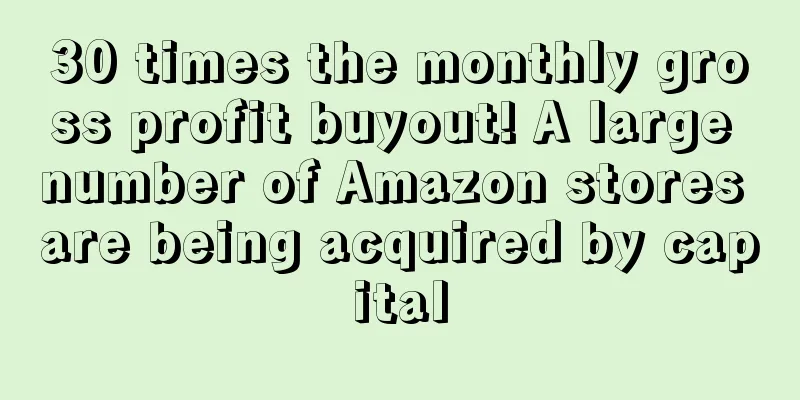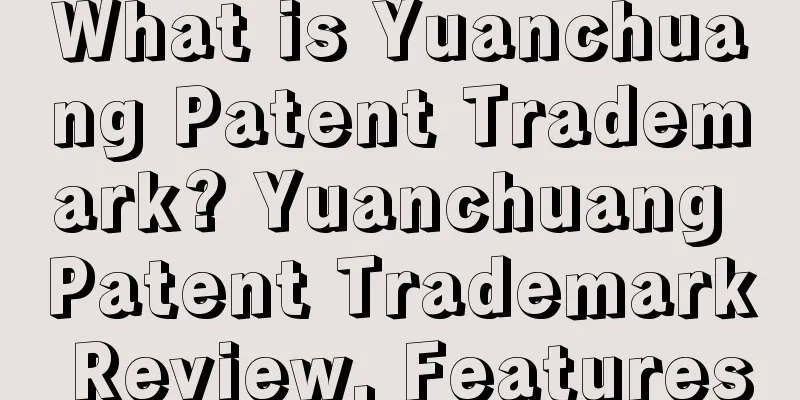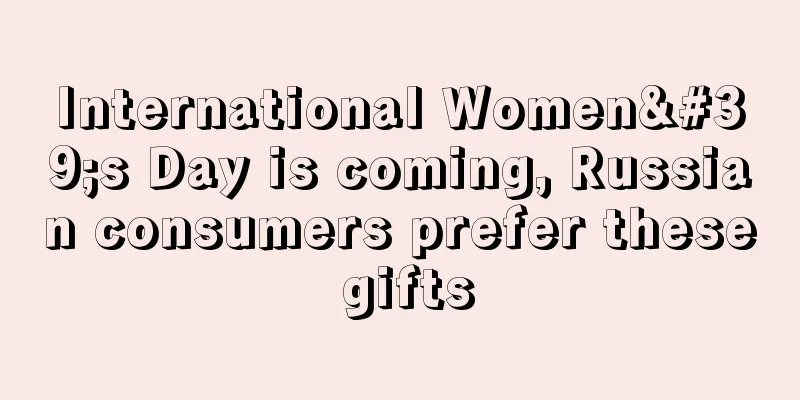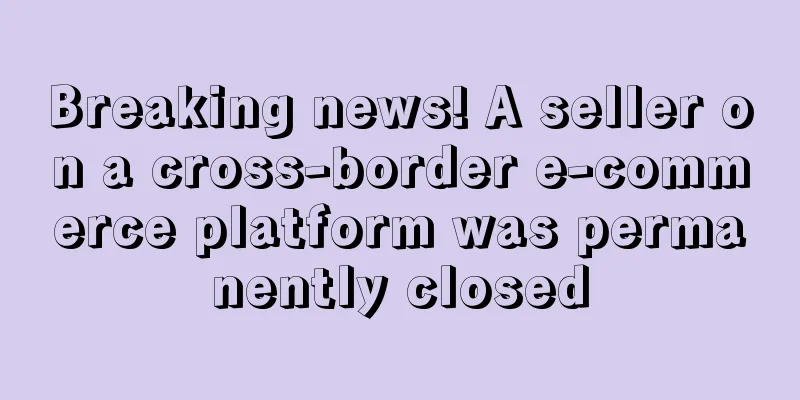30 times the monthly gross profit buyout! A large number of Amazon stores are being acquired by capital

|
Capital buys out Amazon stores , pricing: about 30 times the monthly profit
In the past, the popular practice was to sell an Amazon store for a few thousand to ten thousand dollars. However, starting this year, a number of foreign investors have been purchasing Amazon boutique stores for $1 million or even $10 million . This is not just a rumor, nor is it a once-in-a-lifetime opportunity. It is actually happening to Chinese sellers now, and there are even cases where several capital institutions are competing for a store at the same time.
An Amazon seller, whose store had an average monthly gross profit of $40,000, sold it to an overseas capital institution at a one-time price of $1.2 million . After conversion, the seller could receive about 30 times the monthly gross profit in cash by selling his store. (Note: the inventory value also needs to be considered)
A seller has been targeted by a capital institution, which wants to buy their Amazon store at the price of two years' annual profit, offering $4 million, not counting inventory, but the seller is still considering: "Sales have dropped significantly recently, so I am even more tempted."
Overseas investors advise sellers that if they want to obtain a higher valuation, it is best to sell the project during a period of rapid growth in sales and gross profit. At the same time, according to foreign media reports, acquirers are usually generous and usually buy out the store at 2.5-4.5 times the annual profit . This makes it difficult for sellers not to be tempted, because the amount acquired by each investor will vary, and the value of the store is uncertain, so the 30 times monthly profit pricing may not match all eligible Amazon stores.
Unexpectedly, the appetite of capital is not limited to acquisitions of one or two million US dollars, but is aimed at larger According to feedback from overseas capital institutions, they have completed a project worth 50 million US dollars last year and are carrying out a project worth 15 million US dollars this month.
"The financial standards for the stores we acquire are that their monthly pre-tax gross profit is greater than $30,000, product costs are less than 30%, gross profit is greater than 20%, and profit expectations are stable or rapid growth." The person in charge of the capital connection said, "If the profit is less than $30,000, we will recommend that you raise another account."
"Moreover, small and medium-sized sellers may be our target, and big sellers will not sell their brands easily," he added.
Even though most of the small and medium-sized Amazon sellers in the market do not understand this model, they are all attracted by the possibility of "quick financial freedom".
" After all, it's 30 months of gross profit in cash . Everyone knows the phrase 'cash is king'. If a wave of cash suddenly pours in, you can open another store or supplement the existing store. It's very attractive anyway." A seller in Dongguan sighed. However, not all Amazon stores are eligible for acquisition, and some stores may not be able to sell even if they want to.
Hot money is pouring in, and consortiums are buying Amazon stores.
In fact, the above sellers are not isolated cases. It is no exaggeration to say that Amazon has now become a "fish pond" for foreign capital , who come with a lot of "fish food ( money ) " just to pick the big fat fish.
And Thrasio is the most typical representative among them.
It is one of the largest and earliest companies in the market to integrate third-party sellers on the platform. So far, the company has acquired and integrated more than 100 brands (and 15,000 products) sold on Amazon . For example, Vybe massage guns, Circadian Optics intense light therapy lamps, and Sdara skincare products all belong to the company.
On April 1, Thrasio received $100 million in investment and completed its Series C financing. Not only that, about six weeks before the completion of this round of financing, the company had just received a $750 million injection, and in July last year, the company also received a $260 million injection.
Thrasio only uses this money to do one thing - purchase high-quality Amazon stores.
( Thrasio official website: "Everyone wins when you sell your brand to Thrasio.")
“There aren’t a lot of institutional investors for companies that have less than $5 million in profits,” said Silberstein, one of Thrasio’s founders. “That’s our business.”
Many people may think that the consortium with a long history and strong capital must have the courage and foresight to do such a thing. In fact, Thrasio is very young. It was founded in 2018 and is only 3 years old. However, relying on this business model, it has been profitable since its establishment and is growing wildly.
Specifically, Thrasio's current valuation is 32 times higher than its seed round valuation last year. At the same time, the company's revenue last year was $500 million and its profit was $100 million.
Thrasio's success has greatly stimulated other consortiums, and these jealous latecomers have also brought a lot of funds and are ready to take a chance.
Among them, Berlin Brands Group launched its own business with $150 million in funding earlier this year . One of its "co-founders" is the wealthy European venture capital firm Target Global.
Following closely behind are companies such as Benitago Group, SellerX, Heyday, Heroes, Perch, etc., which have all raised or committed more than $1 billion from their own balance sheets to acquire small but promising third-party merchants.
( Benitago Group official website)
However, compared with other similar peers, Benitago Group, which recently announced the completion of a $55 million financing, is itself an Amazon "native" rather than a simple financial consortium.
Top sellers flock to IPOs to expand , but small and medium-sized sellers find it difficult to break through the scale bottleneck
The influx of a large amount of hot money into Amazon's acquisition of high-quality stores actually reflects the following problem: while the top sellers are flocking to IPOs to expand, small and medium-sized sellers, which account for the vast majority of the seller group, are facing difficulties such as cash flow shortages and difficulty in breaking through scale.
From a seller’s recent complaints on a social media platform, it is not difficult to see their helplessness in the face of this bottleneck.
The seller forwarded a topic "Shenzhen people's money is tied up in mortgages" and said: " My money may be tied up in FBA inventory. The money for shipping this month is always higher than the total transfer amount last month, which has caused me to be short of money and have been stretched every month."
Another seller in the comment section said helplessly: "Next time someone asks me whether Amazon is easy to do business, I will say it's just like stocks. You see, I am still doing it because my money is stuck. It's not that I want to do it, but I can't get out. My money is stuck. "
In fact, the experiences of these two sellers just prove the saying: The bigger Amazon gets, the more money it needs.
In contrast, the top sellers are flocking to IPOs to expand.
For example, Anker, which has attracted great attention in the industry , and VeSync and Gemtek, all successfully IPOed last year.
Recently, some of these companies have submitted their answers for last year.
According to the 2020 annual report recently released by Anker Innovations , the company achieved total operating revenue of 9.353 billion yuan last year , an increase of 40.54% compared with the same period last year ; the net profit attributable to shareholders of the listed company was 856 million yuan, an increase of 18.70% year-on-year; the net profit attributable to shareholders of the listed company after deducting non-recurring gains and losses was 727 million yuan, an increase of 26.28% year-on-year .
It is worth mentioning that last year, the revenue of its smart innovation products doubled, with rapid growth momentum .
In this polarized situation, the number of Amazon sellers is still increasing year by year.
Relevant data shows that there are about 5 million third-party sellers on Amazon today (this number continues to grow), and more than 1 million sellers joined the platform in 2020 alone.
But a considerable number of sellers are troubled by cash flow and scale bottlenecks.
The business model of consortiums such as Thrasio is based on the premise that when the top few sellers are successful in terms of products and brands, many sellers are not yet fully prepared to scale up.
Silberstein and Thrasio estimate that 50,000 businesses on Amazon's platform generate $1 million or more in annual revenue through Amazon.
“When you get into this price range, it becomes very difficult to grow and manage your business,” he said . “SEO, marketing and supply chain management are all challenges that need to be addressed.”
“What that means is that when you grow from $1 million to $10 million, margins go down and it becomes harder to get a return. We observed the reality that all of these sellers had reached a tipping point where they lacked access to capital and could not continue to do what they were doing. We thought if we acquired 10-20 of them and then consolidated the brands, we could build the best scale in terms of assortment supply chain, marketing, etc. ”
Some people may think that this business model of building a brand on a platform is too advanced and too risky.
But the successful launch of Anker, a brand on Amazon , further proves the fact that a meaningful brand can be built on the Amazon marketplace.
What kind of Amazon store (brand) can attract capital?
Although big capital groups are keeping a close eye on Amazon sellers, there are conditions for acquiring Amazon stores.
From the information of the capital acquirer, it can be learned that the product link standards for Amazon brand sellers that meet the buying and selling conditions are that their products have high-quality reviews that far exceed those of competitors, the products are 80% of the revenue source, there are less than 10 product links, the main keyword ranking is at the top of the homepage, and the listing age is preferably more than 24 months.
The financial standards are monthly pre-tax gross profit greater than US$30,000, product cost less than 30%, and gross profit greater than 20%.
Even if an Amazon store meets the above conditions, it may not necessarily be "selected".
The requirements for being "favored" by capital are not low. Ordinary goods without any difference ; electronic products ; product ratings below 4 stars ; continuous decline in profits ; links with obvious traces of black hat operations; accounts that have been warned by Amazon multiple times for violating terms ; seller ratings below 4 stars ; average monthly gross profit of less than 30,000 US dollars in the last 12 months - these are all stores that do not meet the conditions for acquisition. The above mentioned are only the selection criteria of one institution, and the conditions for acquisition by other capital institutions may be different.
All of the above conditions indicate that capital prefers exquisite and beautiful boutique (brand) stores, and a large number of SKUs and no distinctive products have never been a store's "selling point". Boutique and branded operations are also embedded in Amazon's fast-growing track, and the big-selling Anker has never won by having thousands of listings.
Selling your own product? Amazon sellers are in a dilemma
When it comes to selling stores, most Amazon sellers start to feel conflicted. On one hand, there is the "own son", and on the other hand, there is "financial freedom". If your store happens to meet the above criteria and you are attracted to it, would you still be willing to give up your "own son"?
Recently, Hurun Research Institute released the threshold for wealth freedom. The entry-level wealth freedom threshold for China's first-tier cities is 19 million yuan, 12 million yuan for second-tier cities, and 6 million yuan for third-tier cities, as shown in the figure↓↓
Assuming that an Amazon seller who has been in business for two or three years sells his store for $2 million (RMB 13 million) , corresponding to the above picture, he can already achieve entry-level financial freedom in a second-tier city, not to mention selling some higher-value brand stores.
“Isn’t it great to achieve financial freedom? Besides, it’s getting harder and harder to do business on Amazon. On the one hand, the third-party platform is unstable, with store closures and various restrictive policies. If something goes wrong, your account will be blocked and all your hard work will be gone. On the other hand, sales won’t always be that good.” For a group of sellers who have long wanted to escape from the sea of suffering, the truth they have summed up is that they certainly want to sell if they can , but the problem is that no one wants their store.
Of course, another group of sellers feel that they have raised their "own sons" with their own hands and love, and they will not sell them: "If I sell the store, there will be no sustainable profit. After selling it, I don't know what to do, and I don't have the energy to build another one. Besides, I don't want to sell the brand and patents." said a solo seller in Chengdu.
Some sellers also consider issues such as team, supply chain, and inventory: "You can consider not including inventory and team." The capital counterparty interviewed by the editor said that the purchased store was operated by a foreign team.
Whether to sell a store or not, sellers have their own considerations. "Whether to sell or not actually depends on three factors: first, if the gross profit margin does not change much, how fast will the product's future sales grow ? Second, whether the product has a strong ability to drive sales of other additional products? Third, whether the product has personal meaning to you , meaning that cannot be easily bought with money, such as selling your ex-boyfriend's privacy, and you want to torture him slowly. " An Amazon seller revealed.
Capital’s ambition: to build a brand independent of the Amazon ecosystem
Many people may be curious, is it that the huge amount of capital invested is simply to build their own brand on Amazon?
Of course, capital's ambitions do not stop there.
According to the editor, there are two main ways to play this business model in the current capital competition:
One is to spend money to buy data, and then establish an independent brand outside the Amazon ecosystem.
This style of play is mainly represented by Thrasio.
It is reported that Thrasio has been building a huge analytical engine that can mine Amazon data and more to determine which sellers have potential and how to help them sell better, and ultimately build a larger business outside the Amazon ecosystem that covers other markets, other sales channels and direct D2C sales.
The second is to leverage the power of capital to allow the original brand to obtain a greater valuation premium.
This style of play is mainly represented by the Benitago Group, an indigenous Amazonian people .
It is understood that now, Benitago Group has begun to raise funds to purchase more stores and replicate the capabilities they have accumulated in years of operating on Amazon, allowing the original brand to obtain greater profits, thereby allowing the company as a whole to obtain a greater valuation premium!
At this point, Benitago also stressed that it is an Amazon native, not a financial company that only plays numbers.
It is reported that with the entry of institutional investors, Benitago currently has 12 new brands under development and is expected to acquire more than 25 brands before the end of this year.
In conclusion: As Amazon grows, the challenge of bad money driving out good money increases. Improving product exposure, connecting consumers with the best products, and helping these products succeed is obviously an important role.
But there is one issue in this process that deserves our attention, that is, the subsequent operation and planning of these stores after they are acquired, and whether investors can deliver on their promises to sellers and brands.
capital Amazon Platform |
<<: Q1 sales soared 200%, Atterley platform received another £3 million in financing
>>: Indonesian e-commerce company Ula accelerates expansion with $20 million in Series B funding
Recommend
What is FastShip? FastShip Review, Features
<span data-docs-delta="[[20,{"gallery"...
What is KrazyBee? KrazyBee Review, Features
KrazyBee is a consumer finance platform that provi...
Warby Parker's net income in 2021 exceeded 500 million!
On March 17, DTC brand Warby Parker announced its...
Net profit of over 100 million yuan a year? Huge profit business, many cross-border sellers hurt
In the process of going overseas, infringement co...
Guangdong Provincial Department of Commerce and 1688 reached a strategic cooperation, allowing 320,000 factories to learn how to walk on both domestic and foreign trade
Dongguan Praya Textile Factory confirmed this wit...
Latest! The US dollar exchange rate rises to 6.9, sellers: wait for "breaking 7"
Recently, exchange rates have been the focus of d...
What is Tinh Tinh? Tinh Tinh Review, Features
Tinh Tinh is an e-commerce platform launched by Ca...
Whatnot raises $20 million, targeting eBay and Facebook
Foreign media reported that the live streaming pl...
What is MensUnderwearStore? MensUnderwearStore Review, Features
<span data-docs-delta="[[20,{"gallery"...
What is TripleLift? TripleLift Review, Features
TripleLift is a native advertising service provid...
Temu becomes one of the top advertisers in the U.S. with $3 billion in spending
According to foreign media, in order to grab a ce...
What is FiloBlu? FiloBlu Review, Features
FiloBlu is an Italian digital strategy and e-comm...
What is Yicang.com? Yicang.com Review, Features
Since its launch in 2008, Yicang.com has been com...
What is International shopping feature? International shopping feature Review, Features
In April 2018, Amazon launched an international s...
U.S. electronic equipment shipments to decline
During the epidemic, the demand for remote work a...









